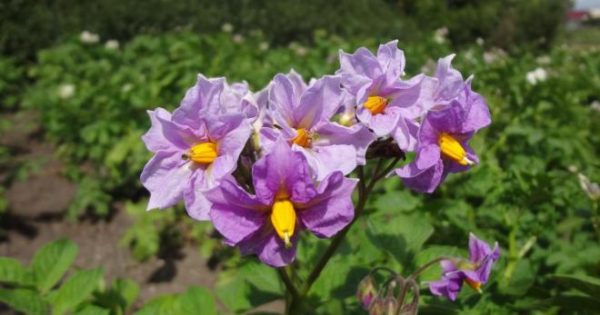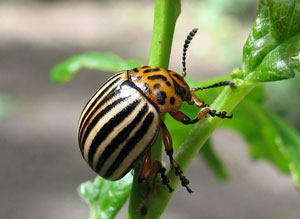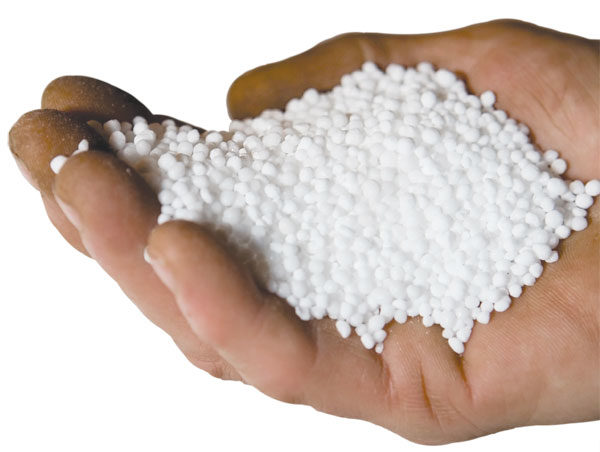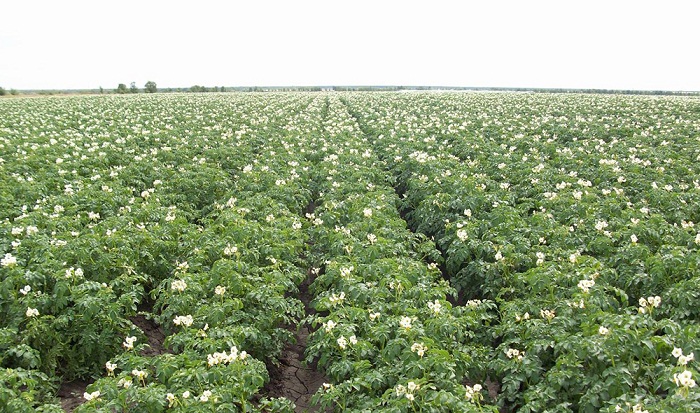Often, farmers believe that the formation of potato root crops is accompanied by flowering of the bush. And there is a kind of belief that there will not be a plentiful harvest if the culture does not bloom in due time. Therefore, the lack of flowering is often a concern. However, the reasons why potato bushes do not bloom are different. Some of them are harmless, and some can really lead to lower yields. What to do in such a situation, you need to decide individually. Sometimes it is enough for a farmer to start observing the basic rules for caring for a potato bush during the growing season.
Content
The importance of flowering and when it occurs

About a month after the planting is completed, the first buds begin to appear on the potato. To accelerate the germination of the seed, it is stored in a warm place for two weeks before planting. During this period, sprouts appear on it, which allows the bushes to bloom 5-7 days earlier. The formation of root crops begins at the end of budding. At a time when potatoes are blooming, future root crops are just beginning to form. Their growth continues until the tops turn yellow, wither and die.
The lush flowering of potatoes is not a guarantee that there will be a lot of tubers. Flowering and growth, the formation of root crops in the soil are not interconnected processes. Breeders have bred a large number of varieties for which it is generally not typical to bloom, but at the same time they bear fruit well. Some farmers cut flowers from bushes to increase the number of tubers. However, this is not recommended. If you walk between rows and remove flowers, then the stems will be damaged, and the soil is rammed. After a few days, the plant will recover, however, it will spend on it its resources necessary for the formation of the root crop.
Why potatoes do not bloom and what to do about it

Sometimes the potato flowers are very small and bloom for a short period of time. Therefore, for farmers, this flowering may go unnoticed. If an ultra-early variety of potato grows in the garden, then it may not bloom at all. In such varieties, root crops are formed separately from the budding period. Breeders have specifically achieved this so that the plant does not expend energy on an unnecessary process. These varieties include Roco, Timo and the Empress. In addition, there are varieties whose flowering depends on the weather. For example, Spring bushes begin to bloom at normal humidity, however, this also does not last long. In dry weather, the development and growth of this plant will take place without flowering.
 You may be interested in:
You may be interested in:If the bushes of mid-season or late-grade potatoes do not bloom, it is necessary to evaluate the growing conditions. The absence of flowering usually results in:
- too high air temperature (in this case, the bush itself looks weak, lethargic);
- deficiency or excess moisture;
- lack of sunlight;
- lack of preliminary preparation before landing of planting material;
- excess nitrogenous fertilizers;
- lack of nutrients in the soil.
In some cases, the flowering of potatoes is prevented by pests. The most common are: ladybug, ground beetle and Colorado potato beetle. They eat flower stalks. If there are too many bugs, they will quickly eat the buds before the onset of flowering.
Sometimes potato bushes do not bloom as a result of a wrinkled mosaic. This disease provokes cooling of the plant in growth. In this case, the leaf plates become wrinkled and acquire a chlorotic color. Affected bushes complete the vegetation early, about a month before the due date. As a result, the number of root crops remains small and they themselves do not increase in size. When struck by a column, the flowers develop incorrectly. Plant growth stops, it turns yellow and fades.
Thus, before planting potatoes, it is important to familiarize yourself with its features and ripening dates, see the photo. If the variety is not early, then peduncles should appear. What to do if mid-season or late-season potato bushes do not bloom, they decide after diagnosing the problem. For example, reducing soil moisture due to frequent rains will not work, but drought can be easily dealt with by watering.
Flowering care

Whether the yield will be large depends on the care. When buds form, potatoes need moisture. Therefore, if there is no rain, caring for potato bushes when the first buds occur includes watering. It should be borne in mind that each bush needs about 3 liters of water. To understand how much moisture is needed, you need to grope the earth at a depth of about 5 cm. If it is wet, you should wait with watering. Excess moisture is also bad. From this, tubers can rot. Water the plantse preferably in the morning or evening. The next day after this you need to loosen the soil and perform the earthing up. As a result, the bushes will receive both moisture and oxygen. After a couple of weeks, the procedure can be repeated.
It is important to consider that large tubers are formed only with sufficient nutrition. Therefore, experienced farmers carry out 2 root top dressing of the crop:
- the first - during the appearance of buds (per meter of a bed in the soil a mixture of 3 tbsp. l ash and 1 tsp. potassium sulfate);
- the second - 5 days after flowering has become massive (2 tbsp. l. superphosphate per 1 m of beds).
Farmers who take special care of potatoes also perform foliar top dressing during budding. Possible options for 10 liters of water (per hundred square meters of the garden):
- 35 g of urea;
- 45 g of potassium sulfate;
- 15 g of ammonium nitrate;
- make a mixture of 2 g of copper sulfate, 10 g of potassium salt and 180 g of superphosphate.
In the flowering phase, it is not advisable to use chemicals against pests. Therefore, if there are few bugs, it is better to assemble them manually. In advanced cases, if the potato bushes do not bloom due to pests, you can spray with a biological product. Bitoxibacillin and Fitoverm are suitable for these purposes. This should be done in clear weather. It is important that after spraying the drug remains on the plant, and it is not washed away by rain.
 You may be interested in:
You may be interested in:Conclusion
By itself, the fact that the potato bloomed or not does not affect the number and size of root crops, however, sometimes its absence indicates problems. In order to eventually dig up a lot of potatoes, you need to take care of the plant as a rule. It should be borne in mind that both a lack of something and an excess are equally harmful. Balance in this case is the key to a good result.




 Description and description of varieties in Belarus with a photo
Description and description of varieties in Belarus with a photo Do I need to pick flowers from potatoes: why do they do it
Do I need to pick flowers from potatoes: why do they do it When to dig potatoes: timing and availability of new potatoes
When to dig potatoes: timing and availability of new potatoes How to grow a good potato crop: various methods and methods, planting and care
How to grow a good potato crop: various methods and methods, planting and care